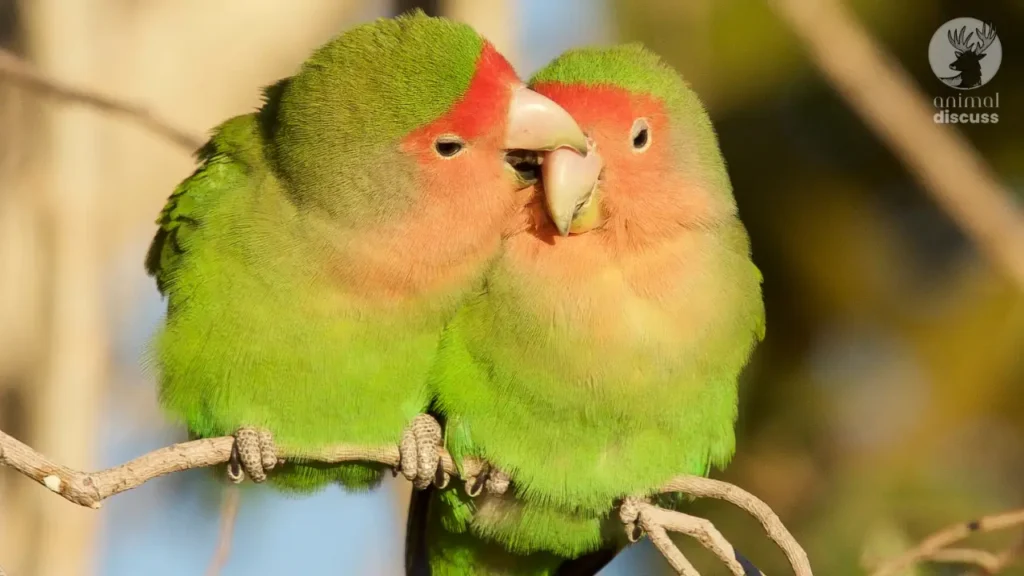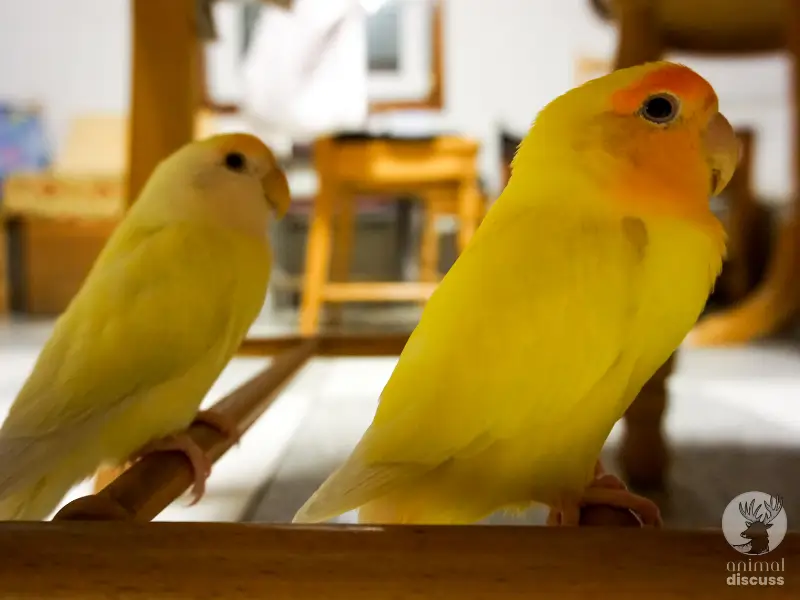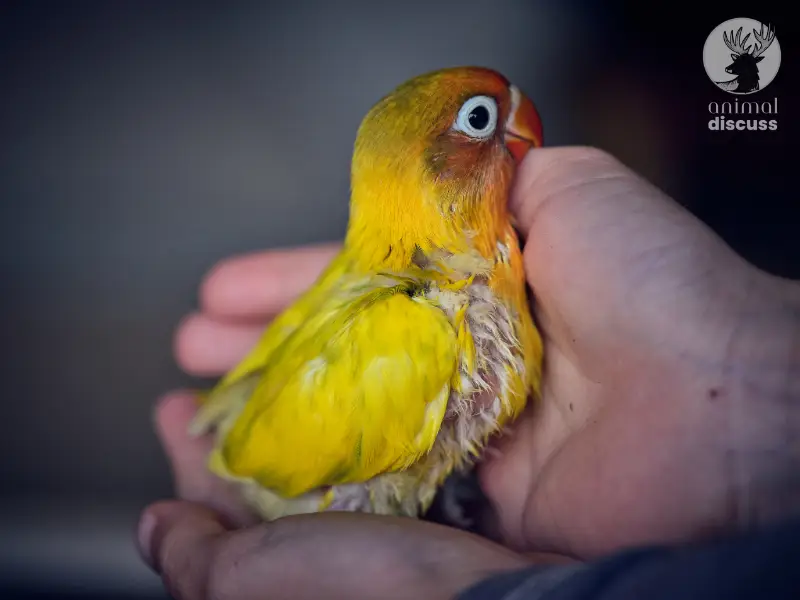This is your ultimate guide to creating the perfect lovebirds habitat. Whether you’re a first-time bird owner or looking to enhance your setup, this guide covers everything you need to know.

Here’s what you’ll learn:
- How to design a space that mimics their natural environment
- Key tips for creating safe indoor and outdoor habitats
- The role of lighting, plants, and mental stimulation
- Proven methods to maintain cleanliness and harmony
- Common mistakes to avoid when housing lovebirds
With these insights, you’ll provide your lovebirds with a space that supports their health, happiness, and unique personalities. Let’s dive in!
1. What is the Ideal Habitat for Lovebirds?
Creating the right habitat is essential for your lovebirds’ health and happiness. Lovebirds thrive in environments that mimic their natural surroundings while meeting their physical and emotional needs. A suitable habitat ensures they stay active, stress-free, and content.
Key Features of a Natural Habitat
- Climate Requirements: Lovebirds originate from subtropical regions like Africa and Madagascar. They prefer temperatures between 70°F to 80°F with moderate humidity levels.
- Space Needs: In the wild, lovebirds fly freely, covering significant distances. A habitat should provide adequate space for similar movement, even indoors.
- Vegetation: Native plants and natural elements like small branches help replicate their environment and reduce stress.
Why Natural Mimicry Matters?
Lovebirds are highly social and sensitive. Replicating their natural environment ensures they remain healthy and less prone to behavioral issues like feather plucking or aggression.
2. How to Create the Perfect Indoor Habitat for Lovebirds?
Lovebirds adapt well to indoor living when their habitat is thoughtfully designed. The goal is to ensure they feel safe, comfortable, and entertained.

Choosing the Right Cage
- Size and Shape: Opt for a cage no smaller than 24x24x36 inches to give lovebirds ample room to move. Horizontal space is crucial as lovebirds fly side to side.
- Material: Use non-toxic, powder-coated metal cages. Avoid painted or galvanized cages, which can be harmful.
Essential Cage Accessories
- Perches: Use a mix of natural wood perches and varying diameters to prevent foot issues.
- Toys: Include chewable items, bells, and foraging toys to keep them entertained.
- Feeders and Waterers: Place them strategically to minimize contamination from droppings.
Cage Placement Tips
Position the cage in a well-lit, ventilated area but away from direct drafts or extreme heat. Avoid placing it in kitchens or near loud appliances.
3. What are the Key Elements of an Outdoor Lovebirds Habitat?
Outdoor aviaries offer lovebirds a taste of nature while ensuring their safety. These setups need careful planning to balance freedom and protection.
Designing an Aviary
- Dimensions: Aviaries should be at least 6 feet tall with enough width for flight.
- Materials: Use sturdy wire mesh to protect against predators while allowing ventilation.
- Safety Measures: Incorporate double doors and secure locks to prevent escapes and keep out intruders.
Weather Protection
- Install shaded areas to protect birds from direct sunlight.
- Use rain shields or covered zones to keep them dry during rains.
Lighting and Ventilation
Proper air circulation prevents respiratory issues, while exposure to natural light supports their circadian rhythms and overall health.
4. Why is Proper Lighting Important in a Lovebirds Habitat?
Lighting plays a significant role in your lovebirds’ health. It affects their mood, activity levels, and even reproductive behavior.
Benefits of Natural Light
- Vitamin D Production: Sunlight helps lovebirds synthesize vitamin D, crucial for their bones and immune system.
- Behavioral Regulation: Proper lighting aligns with their natural cycles, preventing lethargy or hyperactivity.
Using Artificial Lighting
When natural light is insufficient, full-spectrum UV bulbs can fill the gap. These lights should mimic natural sunlight and run for about 10-12 hours daily to replicate day lengths.
5. What Should Be Included in a Lovebird Habitat for Mental Stimulation?
A lovebird’s mind is as active as its body. Without proper mental stimulation, they can develop destructive habits or depression.
Enrichment Essentials
- Toys: Rotate chewable and interactive toys regularly to keep them engaged.
- Foraging Activities: Hide treats in paper cups or puzzle feeders for them to uncover.
- Social Interaction: Spend time daily interacting or talking to your lovebirds.
Variety is Key
Avoid monotony by changing the habitat setup frequently. Adding new toys, swapping perch positions, or introducing new textures can help.
6. How to Maintain Cleanliness in a Lovebirds Habitat?
Cleanliness is the foundation of a healthy habitat. Poor hygiene can lead to diseases, affecting your lovebirds’ lifespan.
Daily Cleaning Routine
- Remove leftover food and droppings.
- Replace water with fresh, clean supplies.
- Wipe perches and toys to remove dirt.
Weekly Deep Cleaning
- Disinfect the cage using bird-safe products like vinegar solutions.
- Wash all accessories thoroughly, ensuring no residue is left.
- Replace bedding or cage liners to avoid mold.
Preventing Health Risks
Maintaining hygiene minimizes the risk of respiratory infections, mites, and bacterial growth.
7. What Plants Are Safe for Lovebirds’ Habitats?
Adding plants enhances the habitat’s natural feel while providing enrichment. However, not all plants are safe for lovebirds.

Safe Plant Options
- Spider Plant
- Bamboo
- Boston Fern
Benefits of Adding Plants
Plants improve air quality and offer hiding spots, helping reduce stress. Chewing safe plants can also aid in natural beak maintenance.
Plants to Avoid
Stay away from toxic plants like pothos, philodendrons, or lilies, which can cause severe reactions in birds.
8. How to Manage a Multi-Lovebird Habitat?
Managing multiple lovebirds requires balance. Overcrowding or poor introductions can lead to stress and aggression.
Introducing New Birds
- Introduce new birds slowly, starting with separate cages.
- Gradually allow supervised interaction to gauge compatibility.
Providing Adequate Space
Ensure at least 3 square feet per bird to prevent territorial disputes. Use multiple feeding stations to minimize competition.
Encouraging Harmony
Keep pairs or bonded birds together to reduce isolation. Provide multiple toys and perches to avoid squabbles over resources.
9. How Can a Habitat Support Lovebirds’ Breeding?
Breeding lovebirds requires specialized care and a conducive environment. Proper preparation ensures healthier offspring.
Nesting Box Essentials
- Use wooden nesting boxes that are cozy and secure.
- Line the boxes with soft materials like shredded paper or untreated wood shavings.
Temperature and Humidity
Maintain stable temperatures between 75°F to 80°F and slightly higher humidity for egg development.
Nutritional Support
Offer calcium-rich foods and high-protein diets during the breeding season to ensure the health of both parents and chicks.
10. What Are Common Habitat Mistakes to Avoid?
Mistakes in habitat management can lead to health and behavioral problems in lovebirds. Awareness is the first step to prevention.
Common Pitfalls
| Mistake | Impact |
|---|---|
| Overcrowding | Causes stress and fights |
| Poor Lighting | Leads to vitamin D deficiency |
| Lack of Stimulation | Triggers boredom and aggression |
| Ignoring Temperature | Weakens immune systems |
How to Avoid Them?
Understand your lovebirds’ needs and stay vigilant. Regularly assess their behavior and adjust the habitat as necessary.
Final Words
Creating the ideal habitat for your lovebirds is essential to their well-being. By ensuring the right balance of space, lighting, and enrichment, you’ll keep them healthy and happy.
Remember, lovebirds thrive in environments that mimic their natural habitat. Regular maintenance and attention to their needs will prevent stress and behavioral issues.
With these tips, you’ll create a safe and stimulating space for your feathered friends to thrive. It’s all about providing them with what they need to live their best life.

